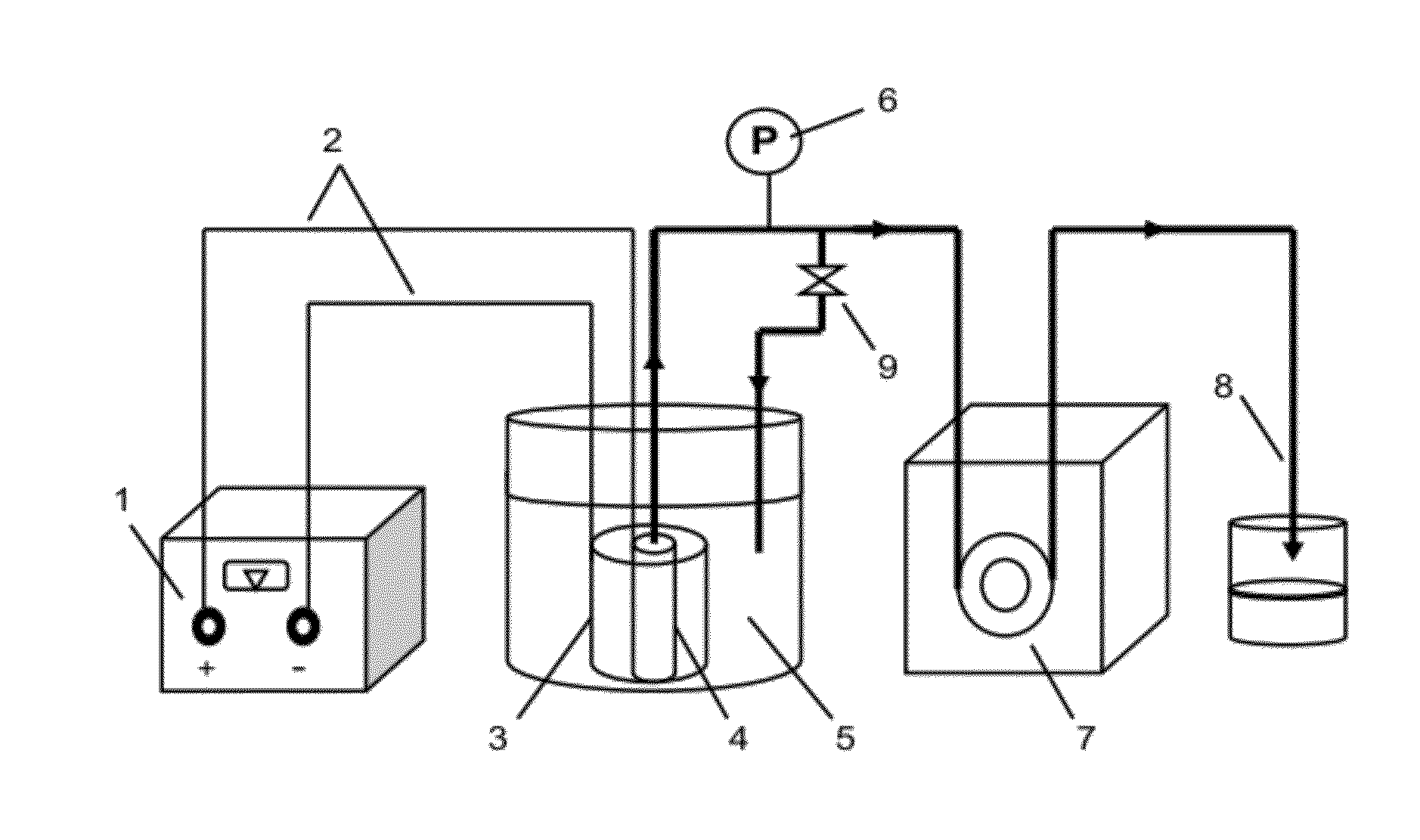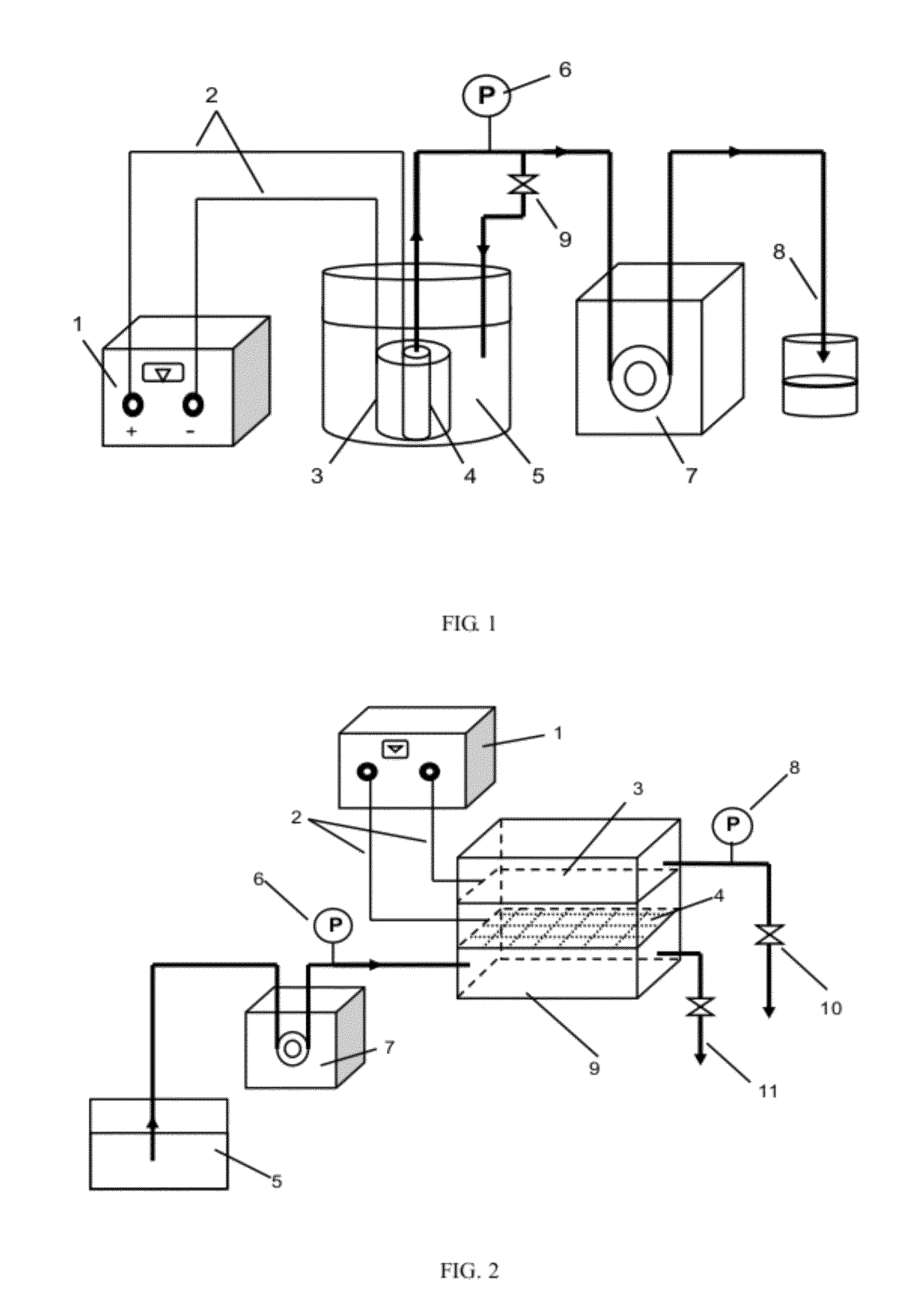Anti-pollution electrocatalysis composite membrane and membrane reactor
a technology of electrocatalysis and composite membrane, which is applied in the direction of membranes, manufacturing tools, electric circuits, etc., can solve the problems of reducing the treatment ability of the membrane, reducing the discharge rate of the membrane, and reducing the treatment efficiency of the membrane, so as to reduce the deposition of the membrane fouling, reduce the discharge rate, and reduce the discharge rate
- Summary
- Abstract
- Description
- Claims
- Application Information
AI Technical Summary
Benefits of technology
Problems solved by technology
Method used
Image
Examples
example 1
[0034]As for the electrocatalytic membrane reactor comprised of the electrocatalytic composite membrane according to the present invention, when the electrocatalytic composite membrane was a tubular membrane, the electrocatalytic membrane reactor formed therefrom was shown in FIG. 1. The electrocatalytic composite membrane 3 was putted into the feed liquid of feed liquid bath 5, wherein the electrocatalytic composite membrane 3 had a closed end and the other end thereof was connected to peristaltic pump 7 by pipelines. Peristaltic pump 7 was used to provide negative pressure continuously so that feed liquid permeates through the electrocatalytic composite membrane 3 from the outside in and flows out via permeate outlet valve 8. A branch regulating valve 9 was arranged on the line of pipes via which permeate flows through. Meanwhile, the electrocatalytic composite membrane 3 as anode and an auxiliary electrode 4 as cathode were connected to an adjustable direct current regulated powe...
example 2
[0036]The electrocatalytic composite membrane in this example consisted of tubular carbon membrane substrate and metal-silica coating.
Substrate: carbon membrane (average pore size 0.6 μm; tubular size Φ8.8 mm×1.4 mm, which meant outer diameter and thickness of the tube, and tubular sizes in the following examples had the same meaning.)
Catalytic coating: Pt / SiO2
Preparation: sol-gel approach
[0037]The above electrocatalytic composite membrane was prepared as follows:[0038](1) substrate pretreatment: a carbon membrane was ultrasonic cleaned for 30 min in ethanol solution, then pretreated for 10 h by hydrogen peroxide solution with a mass percent 20%, and then washed with water and dried at 120° C. in an oven;[0039](2) preparation of Pt / SiO2 sol: ethyl orthosilicate, absolute ethyl alcohol, distilled water and acetylacetone (hydrolysis inhibitor) were mixed uniformly in a molar ratio 1:20:1.5:0.8, then hydrochloric acid was added therein to adjust pH around 2 and the mixture was strongl...
example 3
[0045]The electrocatalytic composite membrane in this example consisted of tubular carbon membrane substrate and metal oxide coating.
Substrate: carbon membrane (average pore size 0.4 μm; tubular size Φ8.8 mm×1.4 mm)
Catalytic coating: TiO2
Preparation: sol-gel approach
[0046]The above electrocatalytic composite membrane was prepared as follows:[0047](1) substrate pretreatment: the substrate pretreatment was the same as that in example 2;[0048](2) preparation of TiO2 sol: tetrabutyl titanate, absolute ethyl alcohol, distilled water, glacial acetic acid and acetylacetone were formulated in a molar ratio 1:18:2:0.2:0.5, then the mixture was strongly stirred for 2 h and was aged for 24 h at room temperature for next step;[0049](3) preparation of composite carbon membrane: the carbon membrane substrate was immersed in TiO2 sol, then stably pulled from the sol at a speed of 3 mm / s after it was settled for 30 s and dried at room temperature;[0050](4) sintering: the coated substrate obtained ...
PUM
| Property | Measurement | Unit |
|---|---|---|
| pore size | aaaaa | aaaaa |
| distance | aaaaa | aaaaa |
| current | aaaaa | aaaaa |
Abstract
Description
Claims
Application Information
 Login to View More
Login to View More - R&D
- Intellectual Property
- Life Sciences
- Materials
- Tech Scout
- Unparalleled Data Quality
- Higher Quality Content
- 60% Fewer Hallucinations
Browse by: Latest US Patents, China's latest patents, Technical Efficacy Thesaurus, Application Domain, Technology Topic, Popular Technical Reports.
© 2025 PatSnap. All rights reserved.Legal|Privacy policy|Modern Slavery Act Transparency Statement|Sitemap|About US| Contact US: help@patsnap.com



